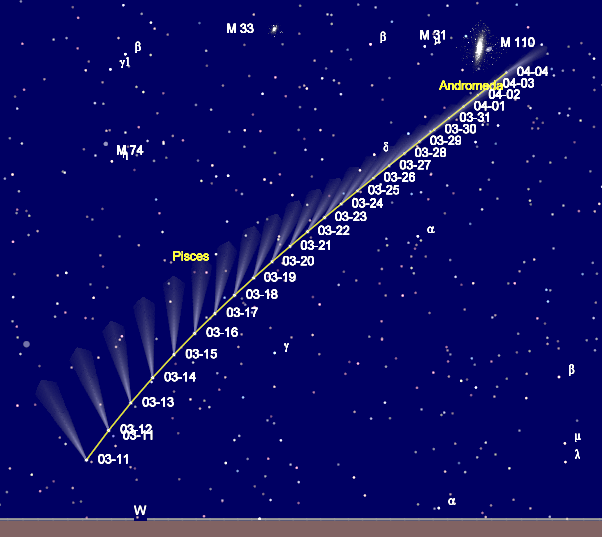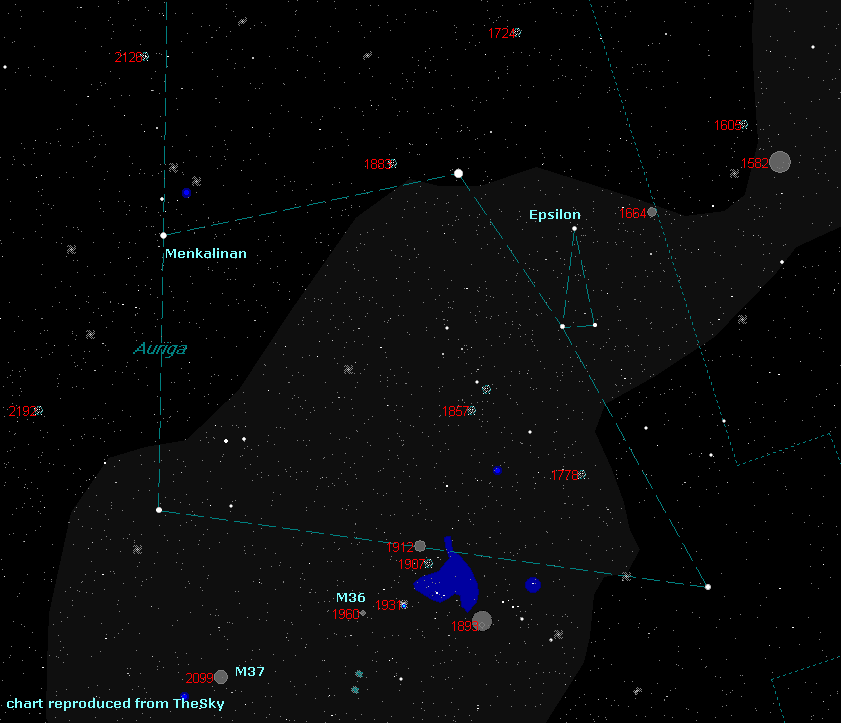Getting Ready For Comet PanSTARRS
In a few days, we in the Northern Hemisphere will be graced by what could be the brightest comet since the 1990s. Discovered on June 6, 2011, by the 1.8-metre Panoramic Survey Telescope and Rapid Response System or PanSTARRS, this (then) 19thmagnitude smudge is on a close encounter with the Sun. Officially catalogued as C/2011 L4, our interstellar visitor will be at its predicted brightest at third magnitude or brighter around March 6 or 7. Here in Canada, that is when we can start to catch the comet just after sunset along the horizon.Each night the comet treks north by about a degree or so and keeps moving higher in the sky towards the constellation of Cassiopeia the Queen. However, it will be dimming rapidly as it pulls away from the solar furnace by one full magnitude every five nights, so plan observing and photography accordingly.
A couple of upcoming digital portraits are March 12 with a less than 2% sliver of a crescent moon lined up to its right as well as April 3 to 5 when the comet sweeps past the Andromeda Galaxy. This comet is a first time visitor from the Oort Cloud and will return 11,000 years from now. Without a track record as seen with other comets, astronomers are not sure how PanSTARRS to perform. The great thing about comets, in particular, is the fascination with the general public. This would be a good opportunity to organize public viewing sessions with telescopes and binoculars.

As February opens, we find Auriga the Charioteer riding high in the night sky. This fine looking group of stars is centred on the meridian at 7 p.m. local time. With about fourteen open clusters calling Auriga home, you would only need binoculars to enjoy this starry landscape. Add to the fact that the lower quadrant of the constellation is nestled against the background Milky Way. Keep in mind you are peering at the thinnest portion of the Milky Way Galaxy and not as prominent as along Cygnus the Swan and down to Sagittarius as seen in summer. Never the less; we still appreciate the collection of background stars.

M37 is one of the prettiest open clusters you will gaze upon in either binoculars or wide-angle telescope. This rich cluster of evenly bright stars measure three-quarters the width of the full moon and can be glimpsed with the naked eye under extremely dark conditions. An estimated 500 stars populate this object of which about 150 are brighter than 12thmagnitude. M37 lays 4,400 light-years away and is about 20 light-years in width. Just over three degrees to the west we find M36.Although this group of about 80 suns is a bit closer to us and smaller, it is not as impressive as M37. Continuing your westerly direction for another two and a half degrees will reward you with a different looking double cluster. The primary is M38 which resides a bit closer to us than M37 but measures the same width. A little lower of M38 we find NGC 1907. These two make a very stunning pair is a very wide-angle telescope.
Located almost halfway between M36 and M38 and a bit south is an interesting complex region of an open cluster NGC 1931 along with a lovely combination of a blue reflection and emission nebula catalogued as IC417. An amazing coincidence is the four hot stars that are embedded in this red region of star birth, look just like the four stars that make up the Trapezium of the Orion Nebula. NGC 1931 holds about 30 suns and is situated 10,000 light-years away.
Epsilon Auriga is a mysterious eclipsing binary. For the past 200 years, astronomers have noticed this star drastically dimming for an extended period of 18 months. This long game of celestial hide and seek occurs every 27.1 years. As eclipsing binaries go, the parent star slightly dips in brightness as the companion star moves in front. In the case of Epsilon, information collected by the Spitzer Telescope has led most astronomers to believe there is a dark disk about eight astronomical units wide, circling the parent star. Many mysteries are still to be resolved on this peculiar object.
Second magnitude Menkalinan is an extremely close eclipsing binary system in which two identical subgiant stars are orbiting a common gravitational point. These suns have a separation only one-fifth the distance of the planet Mercury and the Sun or twelve million kilometres. At this close distance, the stars are yanking and distorting each other resulting in egg-shaped stars, not round. This pair eclipses each other every 3.96 days with a tenth of a magnitude dip in brightness. Just over a degree in the eight o’clock position from Menkalinan is a magnitude 6.7 star cataloged as HD 40979. It is 109 light-years from us and is the parent star to HD 40979b, an extrasolar planet 3.8 times the mass of Jupiter but orbiting .83 astronomical units from the star or about halfway between the orbits of Venus and Earth. One year comprises of 263 days.
The planets Mercury and Venus are pretty well lost in the solar glare. Mars is extremely low in the west and only five degrees from the Sun – so for all intense and purposes, it is lost in the solar glare as well. Jupiter, on the other hand, is still a beacon and appears past the meridian during sunset. Jupiter is about 880 million kilometres from us
Daylight Savings Time occurs on Sunday, March 10th at 2 a.m. and thus spring ahead by one hour in most provinces. This month’s new moon occurs on March 11 at 15:51 EDST and also marks the Chinese New Year – the year of the Snake. A couple of weeks later, the full Worm Moon occurs on March 27 at 5:27 EDT.
Until next month, clear skies everyone.
